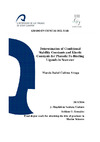Identificador persistente para citar o vincular este elemento:
https://accedacris.ulpgc.es/jspui/handle/10553/55890
| Título: | Determination of conditional stability constants and kinetic constants for phenolic Fe-Binding ligands in seawater | Autores/as: | Cadena Aizaga, Marcia Isabel | Director/a : | Santana Casiano, Juana Magdalena González González, Aridane |
Clasificación UNESCO: | 2307 Química física | Palabras clave: | Biogeoquímica Sewater Acidificación del océano |
Fecha de publicación: | 2016 | Proyectos: | Efecto de la Acidificación y Del Calentamiento Oceánico en El Comportamiento Biogeoquímico Del Fe en El Alántico Norte. | Resumen: | Conditional stability constant and rates of formation and dissociation for the inorganic iron species (Fe′) and for Fe3+ complexation with three model polyphenols,(±) – catechin, sinapic acid and gallic acid were measured in UV-treated seawater by competitive ligand adsorptive stripping voltammetry (CLE-CSV) and kinetic approach using the iron binding ligand TAC (2-(2-thiazolylazo)-p-cresol). Conditional stability constants for the ligands ranged from log K′Fe′L 11.0 to 11.9. The stoichiometry of the complexes formed between dissolved Fe (dFe) and the polyphenols, in UV-seawater, was 3.5:1, 1.5:1 and 1:2.8 for (±) – catechin, sinapic acid and gallic acid, respectively. The formation rate constant varied from 3.82•105 to 4.16•105 M-1s-1 and dissociation rate constant 1.88•10-4– 4.4•10-4s-1. The conditional stability constant (log K′Fe′L) computed from the kinetic approach was from 8.96 to 9.4. The different dFe-binding capacity of polyphenols is highly affected by the interaction with Mg2+ and Ca2+ in seawater. Moreover, the dFe-binding ligands are able to keep Fe in solution for longer between 26 – 61 min for Fe′ species and 0.7 – 1.8 years for Fe3+. | Departamento: | Departamento de Química | Facultad: | Facultad de Ciencias del Mar | Titulación: | Grado en Ciencias del Mar | URI: | https://accedacris.ulpgc.es/handle/10553/55890 |
| Colección: | Trabajo final de grado |
En el caso de que no encuentre el documento puede ser debido a que el centro o las/os autoras/es no autorizan su publicación. Si tiene verdadero interés en el contenido del mismo, puede dirigirse al director/a o directores/as del trabajo cuyos datos encontrará más arriba.
Vista completaVisitas
188
actualizado el 05-jul-2025
Descargas
440
actualizado el 05-jul-2025
Google ScholarTM
Verifica
Comparte
Exporta metadatos
Los elementos en ULPGC accedaCRIS están protegidos por derechos de autor con todos los derechos reservados, a menos que se indique lo contrario.
